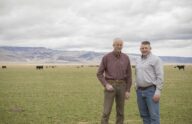A ‘Steppe’ in the Right Direction: BLM’s Proposed Amendments to the Sage-Grouse Rules
Yesterday, PLF filed comments on Bureau of Land Management’s (BLM) proposed amendments to the Greater Sage-Grouse Resource Management Plans in Colorado, Idaho, Oregon, Nevada and Northeastern Californian, Utah, and Wyoming.
The Greater Sage-Grouse is a large ground-dwelling bird. Its habitat is spread across eleven western states where it resides in a sagebrush steppe environment. In 2010, the Department of Interior determined that the listing of the bird under the Endangered Species Act was “warranted but precluded,” meaning that they wanted to list the bird, but that other priorities would have to be taken care of first.
This prompted stakeholders and states across the west to come together to conserve the bird. Recognizing the importance of the bird, and the importance of keeping it off of the Endangered Species list, states acted quickly to establish plans that would save the bird. These plans were developed by stakeholders including state governments, industry members, property owners, and conservationists. Stakeholders worked together to avoid the conflict that ordinarily dominates endangered species issues and focused on collaborating to recover the sage-grouse. Observing their efforts, the Department offered the states the opportunity to collaborate with the federal government to make rules that were similar to the state plans to continue recovery efforts. The states jumped at this opportunity, excited to share what they had learned with the federal government.
In 2015, the Department announced that an Endangered Species Act listing was no longer necessary, in part due to the massive effort undertaken by the states. However, on the same day, the Department also announced the Greater Sage-Grouse Resource Management Plans, regulatory rules that were incredibly burdensome and mostly incompatible with the state-developed plans. States felt as if the Department had promised them a real opportunity to contribute and make a difference only to rip that opportunity away. States and individuals sued, some asserting that the rules had failed to take into consideration the state developed plans and their effectiveness. Congressional members criticized the Department for not considering the state plans in their efforts.
Recently, the BLM determined that amendment of the rules was necessary. The proposed amendments are a step in the right direction of healing the hurt caused by the 2015 plans. BLM’s proposed amendments are tailored to ensure greater compatibility between the federal and state plans. While they are in no means perfect, the amendments strive to reestablish trust between the federal government and the states.
PLF’s comments focused on two main points: (1) the BLM’s proposed amendments aim to harmonize the federal plans with the individual state plans and (2) BLM’s amendments must be submitted to Congress for review once finalized.
PLF appreciates BLM’s nod to the effectiveness of state involvement in conservation of at risk species. State involvement has been essential to the recovery of sage-grouse. States have shown that they are capable of developing responsible and effective plans to preserve species across the board. Take for example, the State of Utah’s plan to recover the Utah prairie dog against a counterproductive federal regulation. In that case the state’s plan (which was allowed to operate for several years due to PLF litigation) was so effective at recovering the prairie dog that the federal government eventually adopted the plan as its own. Similar improvements in sage-grouse recovery were shown prior to enactment of the 2015 federal plans. In Utah, the first full year of implementation of the state plan resulted in a 40% increase in bird population and a quarter million acres of habitat being enhanced and restored.
Furthermore, States are typically better at developing more collaborative plans because individuals have an opportunity to hold state officials accountable for their actions through elections. Accountability at the federal level is more attenuated; the odds that a single vote will influence a presidential election are infinitesimal, and the odds that the vote will affect the President’s selection of the next Secretary of Interior are incomprehensibly small. The state planning process, by contrast, allows for greater citizen engagement and gives disparate groups a stake in the outcome.
But PLF also recognizes that without congressional review, BLM will be unable to legally implement the new plans. Because the amendments are rules under the Congressional Review Act, BLM must submit them to both houses of Congress for review. Submission of the rules allows BLM to begin implementation and gives the public certainty that the plans will be implemented. It also will give the public confidence in the democratic nature of the rules.
BLM never officially submitted the 2015 plans, despite Congress asking for them to be submitted. This means that Congress was never able to take any action to formally disapprove the plans and prevent their implementation. The amendment process gives the BLM the opportunity to right this wrong and submit both the amendments and the original plans to Congress for review.
The proposed amendments allow the federal government to harmonize their existing regulations with the state level protections already in place for the sage-grouse. They also represent the effort to take seriously the conservation plans of individual states. Once the plans are finalized, BLM should submit them to Congress for review as is required by law.


